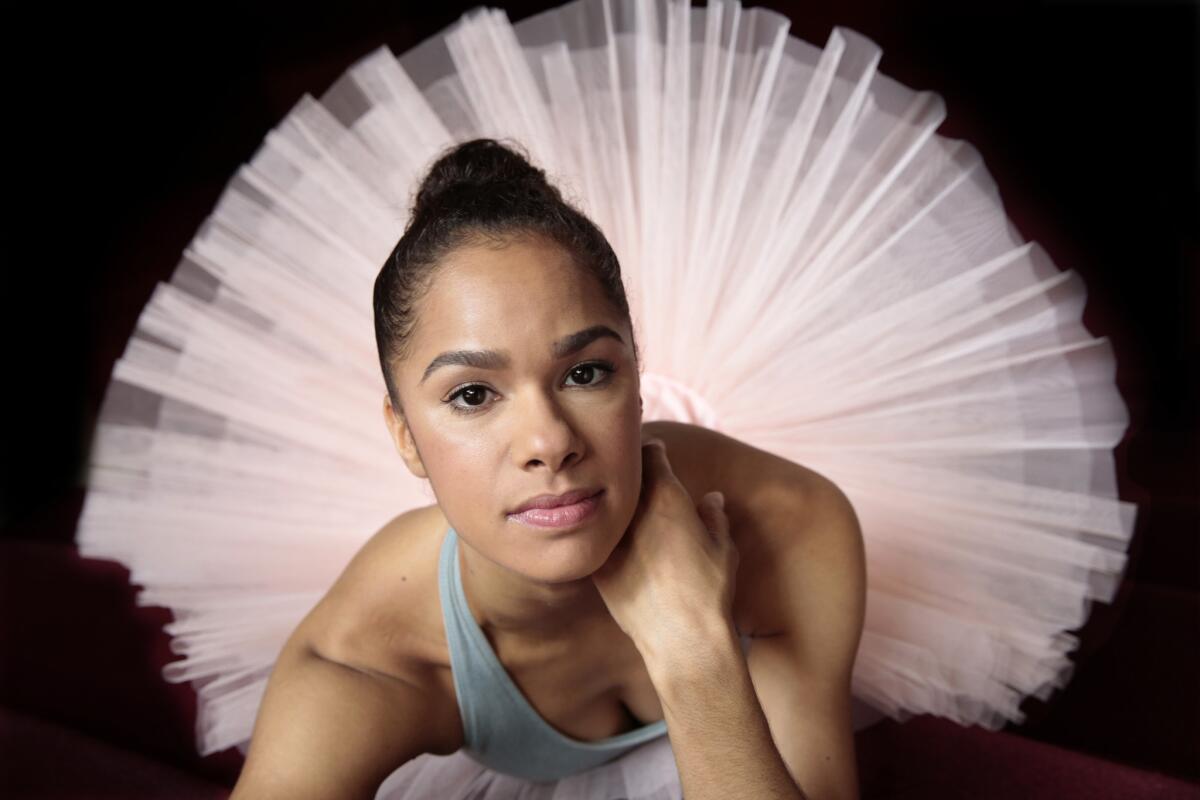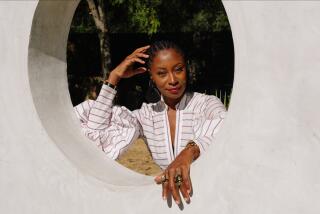Misty Copeland: A trailblazing ballerina makes the judge’s table

Misty Copeland has her feet in a bucket of ice water. It’s symbolic of the hard work it’s taken to become not only a prima ballerina in the American Ballet Theater, but also the first African American ballerina in that venerable company to be featured as the lead in “Coppélia.” Copeland’s ability to continually transcend the dance world will be on display in tonight’s episode, and more upcoming ones, of Fox’s “So You Think You Can Dance” -- where she will be a guest judge.
From the custody battles fought for her as she became a well-known teen dance prodigy, to her ascension as the popular Firebird in a reimagining of the 1910 Stravinsky classic “The Firebird,” Copeland’s rise to the top of the ballet world has been well-documented. A broader opportunity awaits for her and ballet as she joins the popular dance program now in its 11th season. But first, the ice.
What do you do on your Sundays off?
When I’m in rehearsal season, for some reason it doesn’t feel as grueling. There’s something extra that we all just attribute to going onstage. We’re in performance mode at the Metropolitan, and I’m dead. So Sundays, I just chill out. I’m probably going to get dragged around by my boyfriend to shop for the apartment. Otherwise, I’m icing my body and taking care of myself.
What are you working on right now?
I’ll be performing [in a ballet] that was choreographed by George Balanchine called “Duo Concertant.” It’s a pretty beautiful piece; it’s just me and a partner with a violinist and a pianist on stage. Then I will also dance in George Balanchine’s “Themes and Variations” and another old old ballet called “Gaîté Parisienne.” That’s a fun one. It’s got cancan dancers and it’s set in Paris and it’s really uplifting and exciting. And then it changes every week!
Do you enjoy that switching from week to week or would you rather settle into something?
It definitely makes it more exciting that you don’t get complacent in the role that you’re performing because you constantly have to think about what you’re doing to transform into different characters for the different parts. I think the worst part is that when you want to be thinking about the performance that you’re doing that night, you’re rehearsing all day for the ballet you’ll be doing next week. You body is just exhausted.
You’re going to be the first African American ballerina to dance the lead in “Coppélia.” How does it feel to not only get the lead, but be a “first”?
It’s very exciting. I work so hard every day. When I’m given an opportunity like this, performing Swanilda, I really don’t step back and look at the picture thinking “Oh, I’m the first.” I get into this little bubble and just try to do my best and completely do all the research I can on the role. It usually doesn’t hit me until I’ve performed the part and I’m looking back on things. That kind of happened when I performed the role of Firebird (in “The Firebird”) ... I was so completely immersed in becoming this character and being the best I could be that none of those things were on my mind. So, I’m just excited. I actually premiered the role in “Coppélia” in Abu Dhabi in April. It was nice to be able to have an opportunity to view it one time outside of New York City because New York City has, I think, the hardest critics. So it’s good to give newer dancers or roles a chance to do it outside of our city first. I’m excited to share it with New York now.
Speaking of critics, you’re going to be one -- a judge on “So You Think You Can Dance.” What led to that decision?
They were interested in having me on the show. Nigel [Lythgoe] has always been a huge supporter of American Ballet Theater, and to have him acknowledge the importance of ballet in the dance world is really big. To bring it to a commercial level where it is socially acceptable on a program like “So You Think You Can Dance” ... Well, I think it’s about time that we introduce the world to what classical ballet is, and to do it in a fun way. To do it in a way that’s not intimidating; to not have an old Russian woman on [the show] who has her nose up at the dancers. Someone that I think they can connect with and relate to. So, I’m happy to be a representative of ballet. For people to be able to turn on the TV in the smallest towns in middle America and learn about classical ballet through that show is pretty awesome.
What kind of judge do you think you’re going to be?
I think it’s really important to have a good balance of things. Dancers are completely used to having criticism -- that’s why you take classes, to improve and get critiques from teachers. But it’s also still important to get nurtured and get positive feedback. If there’s not a balance, then there’s just no point in being a part of it and it’s no longer fun. I really think that I will find a balance of really trying to help and guide them without putting them down in a negative way. I had an opportunity to get my feet wet in Philadelphia when I did one of the auditions. It was a lot more fun than I anticipated, and it was also really cool to connect with these young dancers and to give them real advice that could help them.
Your base of dance, and your past in general, may have helped you develop a thick skin for criticism. That’s helped in your career, right?
On a personal level, growing up in the situation I did, constantly struggling and having a single mother with six children, I think all of those things gave me qualities that helped me as a dancer. Thick skin and perseverance to keep striving definitely helped me. It’s just a hard existence and some people aren’t built for it. They may have all the talent in the world but just not have what it takes to make it and be able to cheer yourself on as well as allow others to come in and guide and mentor you.
You’ve already written your memoir, and now you have a children’s book coming, too?
The children’s book came about before the memoir. It just happened that the memoir went really quickly and the children’s book took a little time, but it’s with Christopher Myers -- author and illustator. We really clicked and spent hours talking and bonding over our experiences as African Americans and artists. We just felt it out. So, hanging out with me and one of my mentors, Raven Wilkinson, who’s a former ballerina in the Ballet Russe, he decided that was what the story was going to be about. A similar relationship to the one that I have with Raven, that mentor-mentee relationship, except that I would be the mentor and it would be a young brown girl who’s looking up to me. It’s a really sweet story called “The Firebird.”
With the book, you’re embracing being a role model ...
It’s always been something that’s been easy and natural to me. I was never sat down and told “You should think about being a mentor.” It just happens that way. I felt a lot of young, especially African American, dancers migrating towards me. It’s human nature -- you want to go towards something that is similar to you and that feels comfortable to get guidance. And I felt really comfortable giving advice, and it expanded to receiving so many letters and giving advice to young dancers and having personal mentees that I really stay close to and have hands-on experience giving them guidance.
Do you have a favorite dance or character that you’ve been?
It changes. I think that when I’m working on something in that moment, it usually tends to be my favorite. So, right now, I’m gearing up to play the role of Gamzatti. She’s an exotic woman from India who is wealthy and powerful and is dealing with a young water girl who has no money, who has nothing and is trying to steal her man, so that’s what I’m focused on right now.
Do you have a favorite dancer or performer that you’ve seen come through “SYTYCD?”
I have to say Danny Tidwell. Danny Tidwell was one of my closest friends, actually. He came up through ABT and we were extremely close. Again, being in a company as prestigious as ABT you have about 80 dancers; it’s very rare that you see an African American dancer come through, get into the company, and are extremely gifted, and Danny was one of them. It was incredible for the world to be able to see his gifts.
Do you have a favorite judge, or one whose style you could emulate?
First, I love Mary [Murphy]. It was really awesome ... I met her on the set, but I didn’t know what to expect. She’s got this bubbly personality and she’s over-the-top, and I didn’t know if that was something that just happened in front of the cameras. But she was always that way. She was very warm and sweet and is exactly how she appears on the show.
Follow Jevon Phillips: @storiz
More to Read
The complete guide to home viewing
Get Screen Gab for everything about the TV shows and streaming movies everyone’s talking about.
You may occasionally receive promotional content from the Los Angeles Times.







